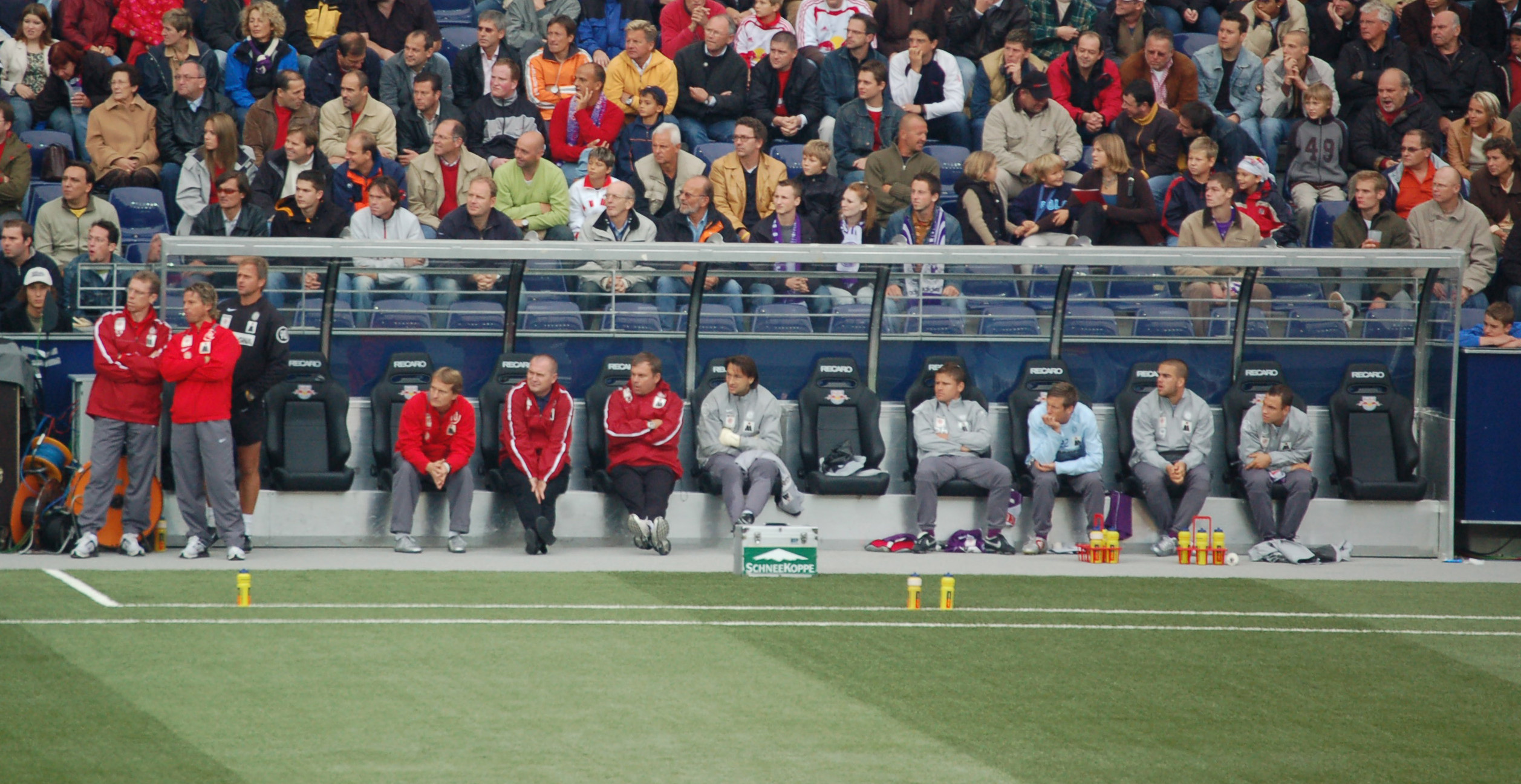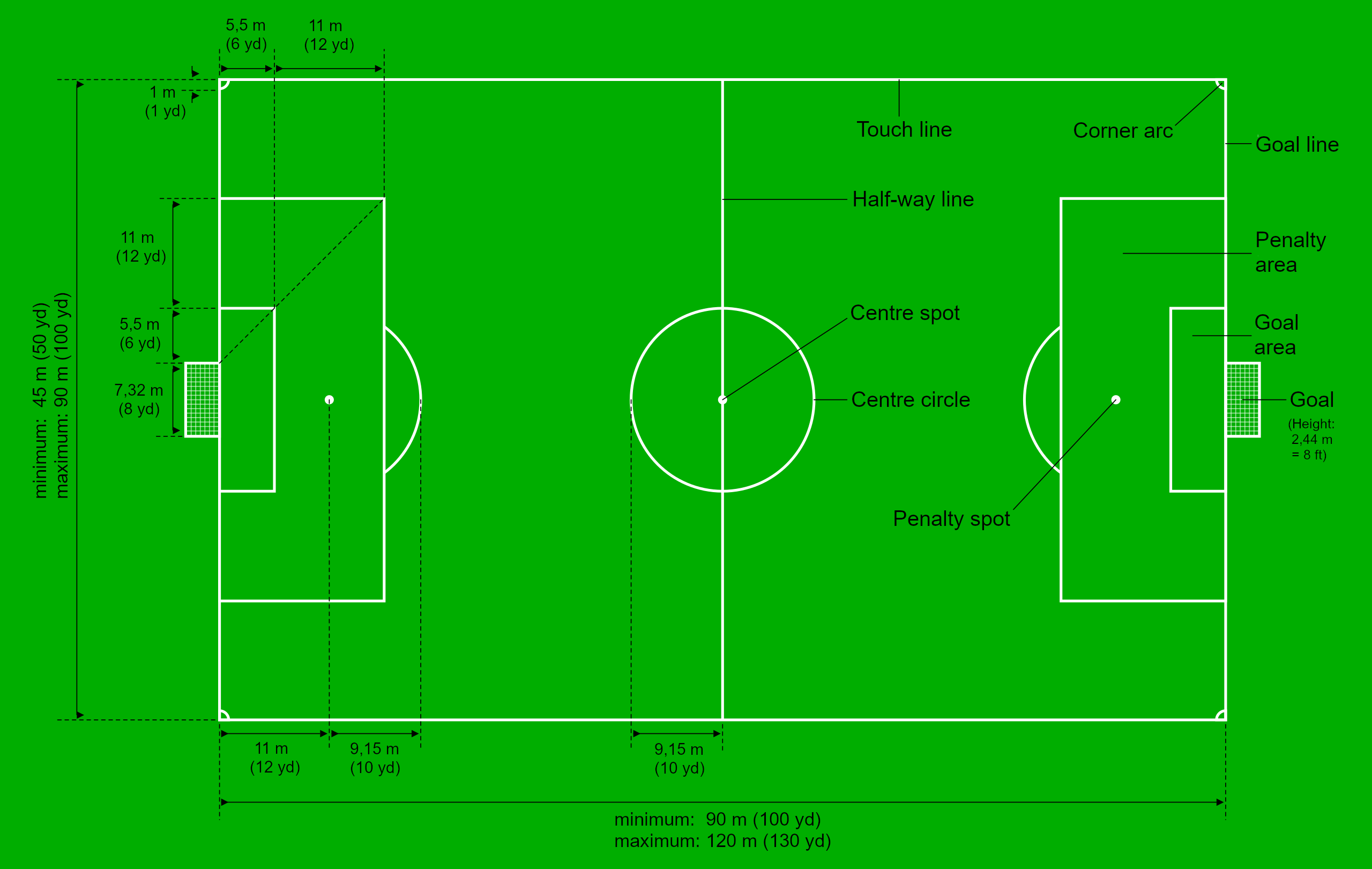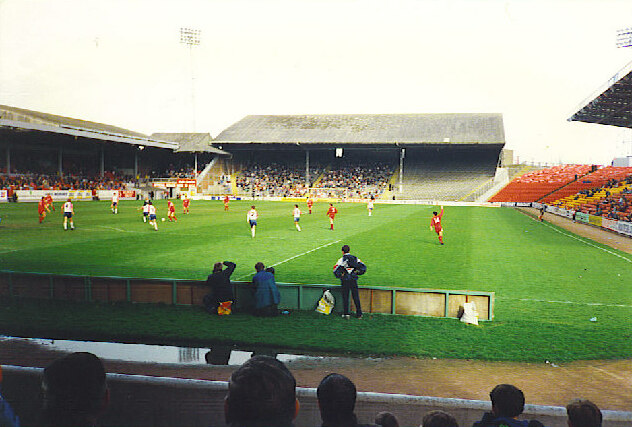|
Technical Area (soccer)
A technical area in association football is an area which a manager, other coaching personnel, and substitutes are allowed to occupy during a match. The technical area includes the dugout, bench and a marked zone adjacent to the pitch. History The first football stadium to feature a dugout was Pittodrie Stadium, home of Aberdeen, where dugouts were introduced by trainer Donald Colman in the 1920s. He wanted a place to take notes and observe his players (especially their feet, hence the reason for being set partially below pitch level) without sacrificing the shelter provided by a grandstand. The defined space of the technical area was established in the notes section of the Laws of the Game in 1993.The Technical Area Laws of the Game, FIFA Op ...
|
Association Football
Association football, more commonly known as football or soccer, is a team sport played between two teams of 11 players who primarily use their feet to propel the ball around a rectangular field called a pitch. The objective of the game is to score more goals than the opposition by moving the ball beyond the goal line into a rectangular framed goal defended by the opposing side. Traditionally, the game has been played over two 45 minute halves, for a total match time of 90 minutes. With an estimated 250 million players active in over 200 countries, it is considered the world's most popular sport. The game of association football is played in accordance with the Laws of the Game, a set of rules that has been in effect since 1863 with the International Football Association Board (IFAB) maintaining them since 1886. The game is played with a football that is in circumference. The two teams compete to get the ball into the other team's goal (between the posts and under t ... [...More Info...] [...Related Items...] OR: [Wikipedia] [Google] [Baidu] |
Manager (association Football)
In association football, the manager is the person who runs a football club or a national team. They have wide-ranging responsibilities, including selecting the team, choosing the tactics, recruiting and transferring players, negotiating player contracts, and speaking to the media. The role exists almost exclusively in the British Isles; in other regions its responsibilities are split between a head coach and a director of football. In the 21st century some British clubs adopted a similar split, but often continue to use the title of 'manager' for their head coach. Responsibilities The manager's responsibilities in a professional football club usually include (but are not limited to) the following: * Selecting the team of players for matches, and their formation. * Planning the strategy, and instructing the players on the pitch. * Motivating players before and during a match. * Delegating duties to the first team coach and the coaching and medical staff. * Scouting for ... [...More Info...] [...Related Items...] OR: [Wikipedia] [Google] [Baidu] |
Substitute (football)
In association football, a substitute is a player who is brought on to the pitch during a match in exchange for an existing player. Substitutions are generally made to replace a player who has become tired or injured, or who is performing poorly, or for tactical reasons (such as bringing a striker on in place of a defender). A player who has been substituted during a match takes no further part in the game, in games played under the standard International Football Association Board Laws of the Game. Substitutions were officially added to the Laws of the Game in 1958. Prior to this most games were played with no changes permitted at all, with occasional exceptions in cases of extreme injury or players not arriving to matches on time. The number of substitutes has risen over time as well as the number of reserve players allowed to be nominated. It is now common for games to allow a maximum of 5 substitutions; some competitions allow for an additional substitution when playing ext ... [...More Info...] [...Related Items...] OR: [Wikipedia] [Google] [Baidu] |
Association Football Pitch
A football pitch (also known as soccer field) is the playing surface for the game of association football. Its dimensions and markings are defined by Law 1 of the Laws of the Game, "The Field of Play". The pitch is typically made of natural turf or artificial turf, although amateur and recreational teams often play on dirt fields. Artificial surfaces are allowed only to be green in colour. All line markings on the pitch form part of the area which they define. For example, a ball on or above the touchline is still on the field of play, and a foul committed over the line bounding the penalty area results in a penalty. Therefore, a ball has to completely cross the touchline to be out of play, and a ball has to wholly cross the goal line (between the goal posts) in order for a goal to be scored; if any part of the ball is still on or above the line, a goal is not scored and the ball is still in play. The field descriptions that apply to adult matches are described below. Becaus ... [...More Info...] [...Related Items...] OR: [Wikipedia] [Google] [Baidu] |
Old Trafford Technical Area Alex Ferguson Sam Allardyce
Old or OLD may refer to: Places *Old, Baranya, Hungary *Old, Northamptonshire, England * Old Street station, a railway and tube station in London (station code OLD) *OLD, IATA code for Old Town Municipal Airport and Seaplane Base, Old Town, Maine, United States People * Old (surname) Music * OLD (band), a grindcore/industrial metal group * ''Old'' (Danny Brown album), a 2013 album by Danny Brown * ''Old'' (Starflyer 59 album), a 2003 album by Starflyer 59 * "Old" (song), a 1995 song by Machine Head *''Old LP'', a 2019 album by That Dog Other uses * ''Old'' (film), a 2021 American thriller film *''Oxford Latin Dictionary'' *Online dating *Over-Locknut Distance (or Dimension), a measurement of a bicycle wheel and frame *Old age See also *List of people known as the Old The Old is an epithet that may refer to: *Basarab the Old, Prince of Wallachia in the 1470s *Emund the Old (died 1060), King of Sweden *Gorm the Old (died 958), first historically recognized king of Denm ... [...More Info...] [...Related Items...] OR: [Wikipedia] [Google] [Baidu] |
Pittodrie Stadium
Pittodrie Stadium, commonly referred to as Pittodrie, is an all-seater stadium in Aberdeen, Scotland. Used primarily for football, it has been the home ground of the Scottish Professional Football League (SPFL) club Aberdeen F.C. since they were formed in 1903. Prior to then, the ground hosted the original Aberdeen F.C. from 1899 until the merger that created the present club. With a seating capacity of ; Pittodrie is the fourth largest stadium in the SPFL and the largest stadium in Scotland outside the Central Belt. Pittodrie has been the location of a number of firsts in the field of stadium design, including the invention of the dugout, and in 1978 became one of the first all-seater stadia in the United Kingdom. , Pittodrie has hosted fifteen matches involving the Scotland national team. The ground has also staged rugby union, with four Scotland international fixtures being held there including a match against the Barbarians. In club football, Inverness Caledonian Thistl ... [...More Info...] [...Related Items...] OR: [Wikipedia] [Google] [Baidu] |
Aberdeen F
Aberdeen (; sco, Aiberdeen ; gd, Obar Dheathain ; la, Aberdonia) is a city in North East Scotland, and is the third most populous city in the country. Aberdeen is one of Scotland's 32 local government council areas (as Aberdeen City), and has a population estimate of for the city of Aberdeen, and for the local council area making it the United Kingdom's 39th most populous built-up area. The city is northeast of Edinburgh and north of London, and is the northernmost major city in the United Kingdom. Aberdeen has a long, sandy coastline and features an oceanic climate, with cool summers and mild, rainy winters. During the mid-18th to mid-20th centuries, Aberdeen's buildings incorporated locally quarried grey granite, which may sparkle like silver because of its high mica content. Since the discovery of North Sea oil in 1969, Aberdeen has been known as the offshore oil capital of Europe. Based upon the discovery of prehistoric villages around the mouths of the rivers ... [...More Info...] [...Related Items...] OR: [Wikipedia] [Google] [Baidu] |
Donald Colman
Donald Cameron Cunningham (14 August 1878 – 4 October 1942), known as Donald Colman, was a Scottish football player and coach (or trainer) in the early years of the 20th century, most notably for Aberdeen. His career in senior football did not begin until he was in his late twenties, and he was capped by Scotland at the late age of 33. As a coach, he was renowned partly as the inventor of the dugout, a sunken, sheltered area for note taking, which he introduced at Aberdeen's Pittodrie Stadium, making it the first football stadium to feature this innovation. Junior career Colman was born and brought up in the Dunbartonshire town of Renton, home of Renton F.C., an early power in the Scottish game. The young Colman was passionate about football, and had helped out at his local club as a boy before signing to play for the Junior club Glasgow Perthshire. Colman feared that his choice of profession would not be favoured by his parents, and signed under his grandmother's name of C ... [...More Info...] [...Related Items...] OR: [Wikipedia] [Google] [Baidu] |
Grandstand
A grandstand is a normally permanent structure for seating spectators. This includes both auto racing and horse racing. The grandstand is in essence like a single section of a stadium, but differs from a stadium in that it does not wrap all or most of the way around. Grandstands may have basic bench seating, but usually have individual chairs like a stadium. Grandstands are also usually covered with a roof, but are open on the front. They are often multi-tiered. Grandstands are found at places like Epsom Downs Racecourse and Atlanta Motor Speedway. They may also be found at fairgrounds, circuses, and outdoor arenas used for rodeos. In the United States, smaller stands are called bleachers, and are usually far more basic and typically single-tiered (hence the difference from a "grand stand"). Early baseball games were often staged at fairgrounds, and the term "grandstand" came along when standalone baseball parks began to be built. A covered bleacher may be call ... [...More Info...] [...Related Items...] OR: [Wikipedia] [Google] [Baidu] |
Laws Of The Game (association Football)
The Laws of the Game are the codified rules of association football. The laws mention the number of players a team should have, the game length, the size of the field and ball, the type and nature of fouls that referees may penalize, the offside law, and many other laws that define the sport. During a match, it is the task of the referee to interpret and enforce the Laws of the Game. There were various attempts to codify rules among the various types of football in the mid-19th century. The extant Laws date back to 1863 where a ruleset was formally adopted by the newly formed Football Association. Over time, the Laws have been amended, and since 1886 they have been maintained by the International Football Association Board (IFAB). The Laws are the only rules of association football FIFA permits its members to use. The Laws currently allow some minor optional variations which can be implemented by national football associations, including some for play at the lowest levels, but ... [...More Info...] [...Related Items...] OR: [Wikipedia] [Google] [Baidu] |
Fourth Official
In association football, an assistant referee (previously known as a linesman or lineswoman) is an official empowered with assisting the referee in enforcing the Laws of the Game during a match. Although assistants are not required under the Laws, at most organised levels of football the match officiating crew consists of the referee and at least two assistant referees. The responsibilities of the various assistant referees are listed in Law 6, "The Other Match Officials". In the current Laws the term "assistant referee" technically refers only to the two officials who generally patrol the touchlines, with the wider range of assistants to the referee given other titles. The assistant referees' duties generally consist of judging when the ball has left the field of play – including which team is entitled to return the ball to play, judging when an offside offence has occurred, and advising the referee when an infringement of the Laws has occurred out of his or her view. These ... [...More Info...] [...Related Items...] OR: [Wikipedia] [Google] [Baidu] |









.jpg)